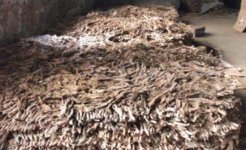Hasankeyf tobacco which is a N. rustica variety has different characteristics than other tobacco varieties grown in Turkey which are mostly N. tabacum. Hasankeyf is grown in Gaziantep province in southestern Turkey, nearby Syrian border. It’s locally called as “deli tütün” (wild tobacco). Unlike Oriental tobaccos Hasankeyf is grown in plain soils that well irrigated and fertilized. It’s also topped for promoting leaf growth and reaching higher levels of nicotine. It’s told that (a rumour) Hasankeyf is introduced from Isfahan region of Iran.

Location of Gaziantep.
Nicotine content of Hasankeyf is higher than other types of tobaccos, like other N. rustica varieties. Leaves have approx. 5.0% of nicotine but may reach higher levels if more fertilizer used.
Height of the plant is 60-100 cm and a single plant produces 8-12 useful leaves. After topping, size of the upper leaves are 25-30 cm in length and 15-20 cm in width. Lower leaves are smaller and are about 15-20 cm in length and 7-10 cm in width. Leaves are petiolate, thick, dark gren and not flexible.
 .......
.......
Photo of a Hasankeyf plant from Jessica's thesis. .........Photo of a Hasankeyf plant in a field.
Hasankeyf variety has no domestic usage in Turkey but some of the local growers use it as snuss with placing it into cigarette rolling paper and call it "ağız otu" (mouth weed). Nearly all of the Hasankeyf tobaccos are exported to Egypt and used for hookah tobacco production by blending it with dark air cured tobaccos of Italy and Malawi.

"Ağız otu"
In the past farmers used to sow seeds directly to soil in spring but now they first grow seedlings in seed beds and then transplant it to field. Within the growing period the fields are irrigated at least 8-10 times. After formation of the flower, plant is topped and 8-12 leaves are left on the plant. Suckering should be controlled not only after topping but also in growing period. Generally 4 weeks after topping plants are ready to harvest. Hasankeyf is stalk harvested but plant/stalk divied into 2-3 parts while stringing and then sun cured.

Sun cured Hasankeyf.
Fermentation takes an important place for Hasankeyf. Sun cured dry leaves may be green to yellow or tan colored. Afer 50-60 days of fermentation in "kürsü" (pilone), leaves turn brown and it’s reddish tones.

Fermentation in "kürsü" (pilone) (with stalk parts).
Companies buy Hasankeyf tobacco from farmers with it's stalks (not stripped) so they strip them and package the leaves with canvas clothes, this bales called as “tonga” and are 40-50 kg in weight.
 ............
............
A "tonga" bale of Hasankeyf.
Now the exportation can begin. Who knows, may be some of world famous hookah tobaccos (generally flavored i.e. Nakhla) contains Hasankeyf.

Location of Gaziantep.
Nicotine content of Hasankeyf is higher than other types of tobaccos, like other N. rustica varieties. Leaves have approx. 5.0% of nicotine but may reach higher levels if more fertilizer used.
Height of the plant is 60-100 cm and a single plant produces 8-12 useful leaves. After topping, size of the upper leaves are 25-30 cm in length and 15-20 cm in width. Lower leaves are smaller and are about 15-20 cm in length and 7-10 cm in width. Leaves are petiolate, thick, dark gren and not flexible.
 .......
.......
Photo of a Hasankeyf plant from Jessica's thesis. .........Photo of a Hasankeyf plant in a field.
Hasankeyf variety has no domestic usage in Turkey but some of the local growers use it as snuss with placing it into cigarette rolling paper and call it "ağız otu" (mouth weed). Nearly all of the Hasankeyf tobaccos are exported to Egypt and used for hookah tobacco production by blending it with dark air cured tobaccos of Italy and Malawi.

"Ağız otu"
In the past farmers used to sow seeds directly to soil in spring but now they first grow seedlings in seed beds and then transplant it to field. Within the growing period the fields are irrigated at least 8-10 times. After formation of the flower, plant is topped and 8-12 leaves are left on the plant. Suckering should be controlled not only after topping but also in growing period. Generally 4 weeks after topping plants are ready to harvest. Hasankeyf is stalk harvested but plant/stalk divied into 2-3 parts while stringing and then sun cured.

Sun cured Hasankeyf.
Fermentation takes an important place for Hasankeyf. Sun cured dry leaves may be green to yellow or tan colored. Afer 50-60 days of fermentation in "kürsü" (pilone), leaves turn brown and it’s reddish tones.

Fermentation in "kürsü" (pilone) (with stalk parts).
Companies buy Hasankeyf tobacco from farmers with it's stalks (not stripped) so they strip them and package the leaves with canvas clothes, this bales called as “tonga” and are 40-50 kg in weight.
 ............
............
A "tonga" bale of Hasankeyf.
Now the exportation can begin. Who knows, may be some of world famous hookah tobaccos (generally flavored i.e. Nakhla) contains Hasankeyf.

